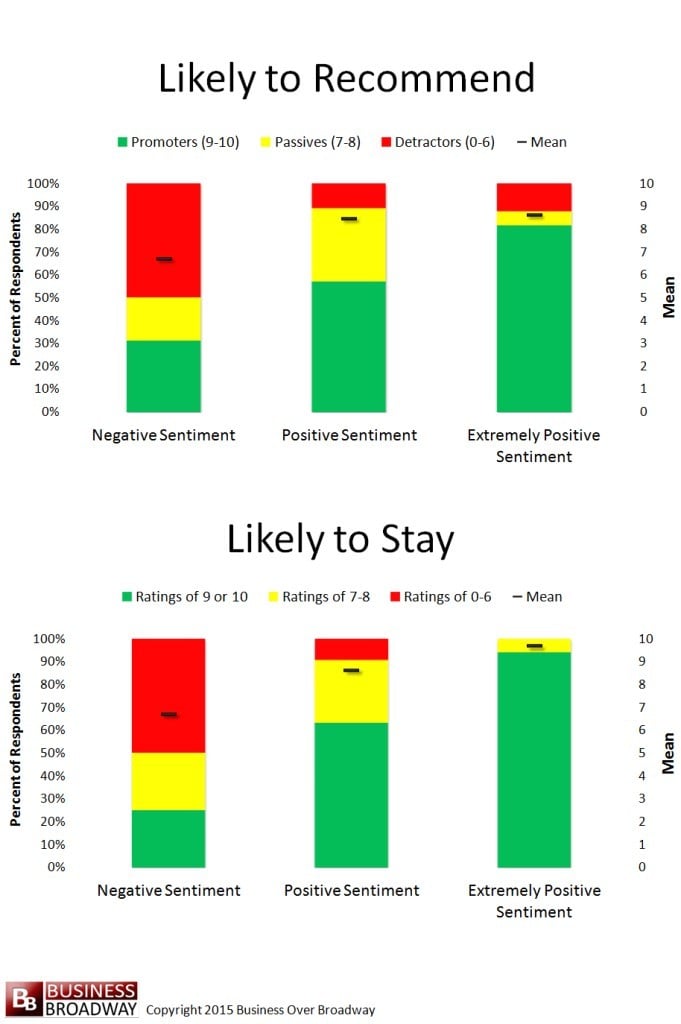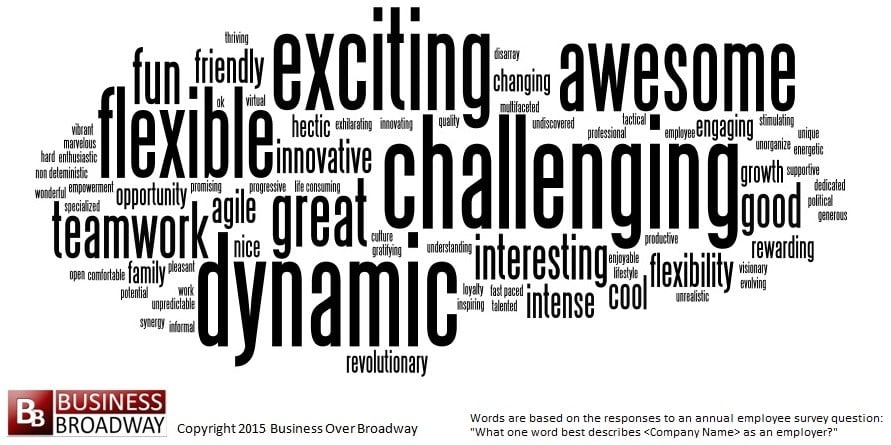Employee surveys are used to help manage the employee relationship. The questions in the employee survey are used to elicit employee responses that will be used to better understand how to improve that relationship. I crafted a new employee survey question by combining two different types of measurement approaches, structured (intentional and standard rating scale) and unstructured (unintentional and text analysis). This approach provides both qualitative and quantitative information you can use to improve how you manage the employee relationship.
Here is the open-ended question: What one word best describes <Company Name> as an employer?
I have one client (startup B2B technology company) who conducts an annual employee survey. Last year, a total of 157 employees completed the survey (response rate of 61%). In addition to the ESI question, their employee survey included other questions, including employee loyalty questions (likelihood to stay, likelihood to recommend) and employee experience questions (26 different questions across variety of areas – supervisor, pay, benefits, work group, promotions, training).
The one word answer can be used in a few ways to provide employee insight. First, you can examine the content of the words to understand your strengths and weaknesses. Second, you assign a sentiment value to the words and use these sentiment values in employee analytics efforts. Finally, depending on the results you get, you can use the words in your employment and recruitment collateral for branding purposes.
1. Identify Company Strengths and Weaknesses
The most frequently used words by the employees are presented in Figure 1. Some words used by many employees included general adjectives such as “Awesome,” “Exciting,” “Great” and “Good.” While these words tell you that employees are generally happy, they are less useful in pinpointing the reasons why they are happy. There were, however, a few words that reflected specific adjectives that provide some insight about the work environment (e.g., “Flexible / Flexibility,” “Teamwork,” “Innovative,” “Agile” and “Hectic”). Taken as a whole, these diverse adjectives paint a generally positive picture of a work environment that is innovative, flexible, hectic and one that supports teamwork.

2. Use Employee Sentiment as a KPI
Calculating a sentiment score is an exercise of mapping each word into a numeric value of sentiment. I used an existing sentiment lexicon that is based on prior research in the area of sentiment measurement (see here, here and here). Each word is assigned a value (based on the lexicon) on a scale from 0 (negative sentiment) to 10 (positive sentiment). This value represents the Employee Sentiment Index.
The average ESI value across the entire set of employee responses was 7.2, reflecting that, on the average, the employees generally have a positive attitude about their employer.
To understand the usefulness of the ESI, I correlated it with the other employee loyalty measures. As you can see in Figure 2, employee sentiment (as measured by the ESI) is positively related to employees’ intentions to stay with the employer and intentions to recommend the employer as a place to work.

The ESI could be used as a key performance index for use in employee analytics efforts that identify the causes of employee sentiment. Furthermore, the ESI could be included in executive dashboards as a good overall metric of the health of the employee-employer relationship.
3. Improve Company Branding
The list of words that employees use to describe you paints a general picture of your company. Create a word cloud to help you communicate the survey results to the company. Additionally, you can use the word cloud as part of your recruitment efforts to attract new employees. My client used their word cloud as part of their employee on-boarding process (see an initial mock up of their word cloud in Figure 3.

Summary
I presented a measurement approach to help businesses manage the health of the employee relationship. The proposed method reflects an intentional measurement approach using unstructured data. The measurement approach offers a variety of benefits:
- Identify company strengths/weaknesses. The content of the words that the employees use can be examined to to understand common themes.
- Use employee sentiment as a KPI. The ESI measures the extent to which employees hold positive sentiment toward their employer. This quantifiable metric can be used to track progress over time. The ESI is predictive of other important organizational measures including turnover intentions and likelihood to recommend the employer.
- Improve company branding. Depending on the results, you can use word clouds for employment collateral to support recruitment and employee orientation activities.
Results of the analyses show that the measurement method provides useful information about your employees. Try using this question in your next employee survey to better understand how to better manage your employee relationships.




If you go with the assumption that having employees who are happy and content portends better customer experiences than having employees who are disgruntled, this seems a valuable effort. I mention this not to be facetious, but because in many companies, that assumption isn’t always a given. I like the questions you ask, because they are often taken for granted. In addition, I’m interested in the word map and analysis for other questions, such as:
1) “The word that best describes my relationship with my co-workers is _______.”
2) “When I am at work here, my mood is mostly ________.”
3) “As an employee, the experience of working with our company’s customers is ______________.”
One word that almost never appears in such lists asn an enterprise strength or weakness is “customer-centric”. As noted in Hal Rosenbluth’s and Diane Peters’ classic book, The Customer Comes Second, is the organization strategically focusing on employees in such a way that enables and empowers them to strategically focus on customers? This creates a customer-obsessed culture where optimal customer experiences can be achieved and where employee ambassadorial behavior can flourish: http://customerthink.com/do-you-really-wanna-work-here/